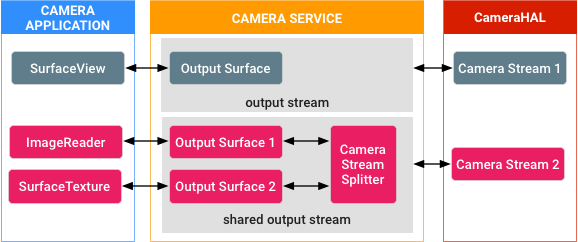Fitur ini memperkenalkan serangkaian metode yang memungkinkan klien kamera menambahkan dan menghapus permukaan output secara dinamis saat sesi pengambilan aktif dan streaming kamera sedang berlangsung. Output baru dapat dipetakan ke aliran kamera bersama tertentu yang dipilih pengguna. Setelah ditambahkan, platform dapat dihapus kapan saja.
Idenya adalah untuk membagikan buffer yang terkait dengan aliran kamera tertentu dalam beberapa platform output. Penghitung referensi internal melacak buffer saat buffer siap untuk diproses lebih lanjut di sisi konsumen. Saat semua konsumen menyelesaikan tugas masing-masing, buffer akan dikeluarkan dari antrean dan tersedia untuk kamera.

Gambar 1. Berbagi buffer
Gambar 1 menggambarkan satu contoh skenario saat buffer yang diproses oleh streaming kamera 2 dilampirkan dan dilepas secara dinamis, dihitung referensinya, dan dikelola oleh komponen pemisah streaming di dalam streaming output bersama khusus dalam layanan kamera.
Contoh dan sumber
Implementasi inti fitur ini dapat ditemukan di modul
Camera3StreamSplitter. Dokumentasi tentang fitur ini dapat ditemukan di referensi developer:
Implementasi
Tidak ada implementasi yang diperlukan di sisi HAL Kamera karena fitur ini diimplementasikan di sisi framework.
Validasi
Implementasi Anda harus lulus kasus CTS yang mencakup fitur ini dari modul MultiViewTest dan library JNI native untuk API native.

